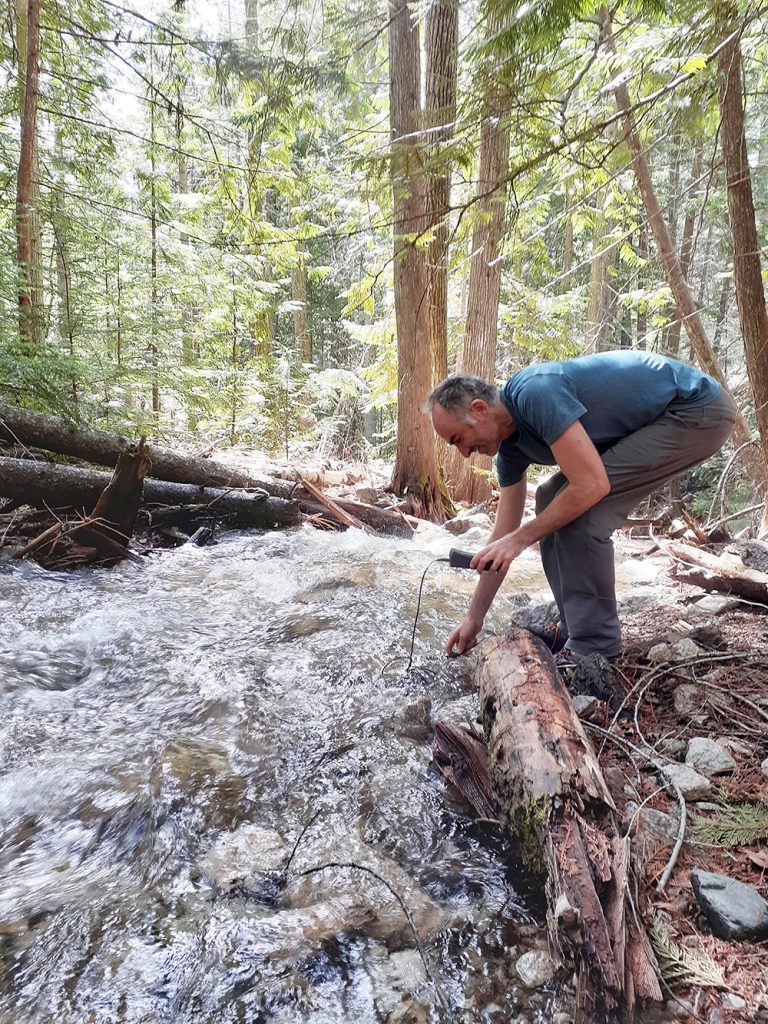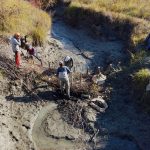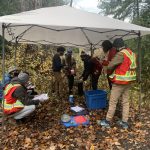Securing our water in a low-to-no snow future

One of Living Lakes Canada’s water monitoring programs, Kootenay Watershed Science is working to improve understanding and prediction of how small- and medium-sized watersheds are going to behave in a changing climate. Living Lakes Canada Photo
By Living Lakes Canada
Have you ever thought about what a future with less snow might look like? Okay, so we’ve still seen plenty of snow this winter, but as temperatures continue to skyrocket with longer periods of heat and drought, climate models are predicting the disappearance of snow as we know it. In the coming decades, increasingly smaller snowpacks will also melt faster. Where will this leave us?
Less snow and disappearing glaciers means we will be faced with tougher choices and fewer options about how we use water. It will be harder to fill our reservoirs to provide for irrigation and the water supply for cities and towns. And because these same water sources also provide for industrial and commercial purposes, we will be forced to make decisions about how much water can be diverted while guaranteeing drinking water for our communities. What about hydro power generation? Or fighting increasingly common wildfires? With less rain during the growing season, farming will put increasing demands on surface and groundwater systems. Where does water for recreation sit within this thinking? Will we have the luxury of keeping our golf courses green and making snow for our ski resorts? And what about fish and other aquatic species, already suffering from decreased stream flow and warmer water temperatures? In a low-to-no snow future, conserving and budgeting increasingly precious water sources is a necessity we have so far blissfully ignored.
“We need a paradigm shift in how we manage water and who is involved in these decisions. We need new ways of thinking and valuing water if we hope to successfully navigate the most serious looming challenge of the 21st century,” says Kat Hartwig, Executive Director of Living Lakes Canada.
Living Lakes Canada is a national water stewardship NGO based in southeast British Columbia taking a practical approach to confronting the emerging water crisis. Living Lakes Canada partners with First Nations, community groups, other non-profits, academia, industry, and all levels of government to tackle a variety of water-related projects across Canada. By monitoring streams, rivers, lakes, wetlands and groundwater, Living Lakes Canada strives to support our collective understanding of the constraints on water quantity and quality, and identify strategies and solutions for protecting this invaluable resource in our changing climate.
In the Canadian Columbia Basin, Living Lakes Canada is quantifying how much water we have and how much is needed for supporting livelihoods and ecosystems in a warmer future where water availability will be fundamentally changed. It’s an innovative pilot project that integrates users and local perspectives to develop a practical template for other regions that will inevitably grapple with the same water challenges.
This modernized water protection work will be critical for supporting government policies around sustainable water management. It’s for this reason Living Lakes Canada supports the creation of a dedicated Watershed Security Strategy and Fund for B.C., to guarantee continued government support for important water-related study. The Province of British Columbia has begun developing the Watershed Security Strategy and Fund with Indigenous Peoples and in collaboration with other levels of government. A Discussion Paper has been published and the public is invited to provide feedback up until March 18 at 4 p.m. PT.
Just as the Province subsidizes fossil fuels, forestry and farming, now is the time for the Province to consider water in the same way and seriously commit to funding watershed protection. According to a 2021 report, B.C.’s watershed sector adds an estimated $5 billion to the provincial GDP. Watersheds also have immense cultural and spiritual value, and afford us opportunities to get outside, connect with nature and recreate. Most importantly, watersheds give us water, and water is life. In a 2021 poll, B.C. residents declared water as their top environmental issue of concern. Now is the time to tell the provincial government why you’re concerned about your local watershed and how water protection can be improved to secure our future.
To share your thoughts, complete the survey at https://engage.gov.bc.ca/watershedsecurity.





